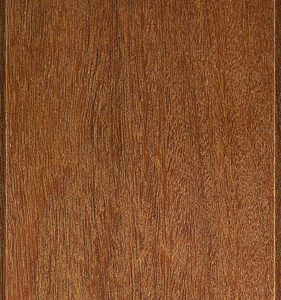Cumaru, Brazilian Teak
(Dipteryx odorata)
Average Dried Weight: 68 lbs/ft 3 (1,085 kg/m 3 )
Specific Gravity (Basic, 12% MC): .86, 1.09
Janka Hardness: 3,330 lb f (14,800 N)
Modulus of Rupture: 25,390 lb f /in 2 (175.1 MPa)
Elastic Modulus: 3,237,000 lb f /in 2 (22.33 GPa)
Crushing Strength: 13,850 lb f /in 2 (95.5 MPa)
Shrinkage: Radial: 5.3%, Tangential: 7.7%, Volumetric: 12.6%, T/R
Ratio: 1.5
Color/Appearance: Heartwood tends to be a medium to dark brown,
sometimes with a reddish or purplish hue; some pieces may have streaks
of yellowish or greenish brown.
Grain/Texture: Grain is interlocked, with a medium texture and a waxy
feel.
Endgrain: Diffuse-porous; solitary and radial multiples; large pores in
no specific arrangement, few; heartwood mineral/gum deposits present;
parenchyma lozenge, aliform, confluent, and sometimes marginal; narrow
rays, spacing fairly close.
Rot Resistance: Cumaru has excellent durability and weathering
properties. The wood is rated as very durable regarding decay resistance,
with good resistance to termites and other dry-wood borers.
Workability: Tends to be difficult to work on account of its density and
interlocked grain. If the grain is not too interlocked, Cumaru can be
surface-planed to a smooth finish. However, the wood contains silica and
will have a moderate blunting effect on tool cutters. Due to its high oil
content and density, Cumaru can present difficulties in gluing, and pre-
boring is necessary when screwing or nailing the wood.
Common Uses: Flooring, cabinetry, furniture, heavy construction,
docks, railroad ties, bearings, handles, and other turned objects.
Useful info’s : Wood of the species Dipteryx odorata is most commonly
called Cumaru among most woodworkers, though it is sometimes referred
to as Brazilian Teak as well: primarily when used as hardwood flooring.
(Brazilian Teak is not related to the wood that is most commonly
called Teak, Tectona grandis.)
Cumaru is also called by the name Tonka Bean, and the tree is commonly
cultivated for its vanilla-cinnamon scented seed—the tonka bean—which
contains a chemical compound called coumarin.
Cumaru lumber is extremely stiff, strong, and hard, lending itself well to a
variety of applications. It is sometimes used in place of the much more
scarce Lignum Vitae.
The heartwood fluoresces under a blacklight, which can help distinguish it
from Ipe .

